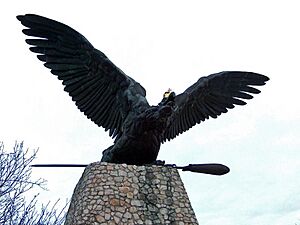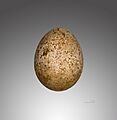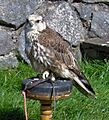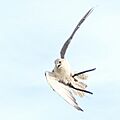Saker falcon facts for kids
Quick facts for kids Saker falcon |
|
|---|---|
 |
|
| In Tibet | |
| Conservation status | |
| Scientific classification | |
| Genus: |
Falco
|
| Species: |
cherrug
|
 |
|
| Range of F. cherrug Breeding Resident Passage Non-breeding | |
| Synonyms | |
|
|
The saker falcon (Falco cherrug) is a large and powerful falcon species. These amazing birds live across a huge area, from Central Europe all the way east to Manchuria in Asia.
Saker falcons are partial migrants. This means some of them travel long distances for winter, while others stay in the same place all year. Young falcons in Europe often migrate, but adult falcons usually stay put. European and West Asian sakers fly to the Sahel region in Africa for winter. On their journey, they cross the Middle East, Arabian peninsula, and Pakistan. Sadly, they sometimes face illegal trapping during these trips. Sakers from the Altai Mountains in the east spend their winters in the Qinghai-Tibet Plateau.
The saker falcon is incredibly fast! It's the second fastest bird in level flight, reaching speeds of about 150 miles per hour (240 km/h). It's also one of the fastest animals overall, especially when it dives from the sky. These high-speed dives, called "stoops," can reach nearly 300 miles per hour (480 km/h). The saker falcon is a special bird in many countries. It is the national bird of Hungary, the United Arab Emirates, and Mongolia. In Arabic, it's called Hur, meaning "Free-bird." People in the Arabic peninsula have used these falcons for hunting, a sport called falconry, for thousands of years.
Contents
Understanding Saker Falcons
The saker falcon belongs to a group of falcons called hierofalcons. These birds are very closely related. Scientists study their DNA to understand how they are connected. It seems that all the different types of hierofalcons we see today developed quite recently, about 130,000 to 115,000 years ago. The saker falcon's ancestors likely spread from northeastern Africa into Europe and Asia.
Different Types of Saker Falcons
The Saker Falcon has four officially recognized types, called subspecies. These are slightly different versions of the same species, often found in different places:
- F.c. cherrug: This is the main type, found from Central Europe to Central Asia.
- F.c. coatsi: This type lives in the desert areas of West and South Kazakhstan and Uzbekistan.
- F.c. milvipes: This type is common in most parts of Central Asia.
- F.c. hendersoni: This type lives in the high mountains of Tibet and the Qinghai Plateau.
Some sakers living near the Altai Mountains are a bit bigger and darker. These are sometimes called the Altai falcon. For a while, people thought they might be a separate species or a mix of saker and gyrfalcon. But new research shows they are just a color variation of the saker falcon. They are not a different species.
The name cherrug comes from the Sindhi word charg, which is what people in the Sindhi language call a female saker. The name saker comes from the Arabic word Ṣaqr, which simply means "falcon."
What Does a Saker Falcon Look Like?
The saker falcon is a large bird of prey. It's bigger than a lanner falcon and almost as big as a gyrfalcon. Saker falcons are about 45 to 57 centimeters (18 to 22 inches) long. Their wings can spread out from 97 to 126 centimeters (38 to 50 inches) wide.
Male sakers usually weigh between 730 and 990 grams (1.6 to 2.2 pounds). Females are larger, weighing from 970 to 1300 grams (2.1 to 2.9 pounds). Their feathers can vary in color, but they are generally brownish. Both males and females look similar, except for their size. Young birds are usually darker with more streaks. When a saker falcon calls, it makes a sharp kiy-ee sound or a repeated kyak-kyak-kyak.
Saker Falcon Life and Habitat
Saker falcons are raptors, which means they are birds of prey. They prefer to live in open grasslands, especially where there are some trees or cliffs. They hunt by flying horizontally and chasing their prey, rather than diving from high up like a peregrine falcon.
Their main food includes rodents and other birds. In Europe, they often hunt European ground squirrels and feral pigeons. Saker falcons usually don't build their own nests. Instead, they use old stick nests that other birds, like storks or ravens, have left behind in trees. They also often nest on cliffs.
Protecting Saker Falcons
The saker falcon is an endangered species. This means its population is rapidly shrinking, especially in Central Asia. One big reason for this decline is illegal trapping. After the Soviet Union broke apart, many thousands of falcons were caught and sold illegally. Kazakhstan alone is thought to lose up to 1,000 saker falcons each year to this illegal trade.
Saker falcons also face problems from their habitats being lost or destroyed. In 2004, there were estimated to be only about 7,200 to 8,800 adult sakers left. Because they live in remote areas and spread out widely, it's hard to count them all. However, there are good conservation efforts. In the United States, Canada, and Europe, there are projects to breed sakers in captivity to help their numbers grow. Hungary has a well-protected and healthy population of sakers.
Saker falcons can get sick from bird flu. Scientists have found that vaccinating sakers can protect them from serious bird flu strains, at least when they are in captivity. This is good news for protecting these important birds.
Saker Falcons in Culture
The saker falcon is a very important bird in many cultures. In Hungary, a mythological bird called the Turul was likely a saker falcon. Today, the saker falcon is the national bird of Hungary. In 2012, it also became the national bird of Mongolia.
Saker Falcons and Falconry
Saker falcons have been used in the sport of falconry for thousands of years. They are highly valued because they are swift and powerful hunters. They are very good at catching medium-sized to large birds. Saker falcons can fly at speeds of 120 to 150 kilometers per hour (75 to 93 mph) and dive suddenly to catch their prey. Sometimes, saker falcons are even bred with peregrine falcons to create hybrid falcons that are used to control larger pest birds.
Images for kids
-
Captive bird, Chew Valley Lake, England
-
Falcon training in Moscow











